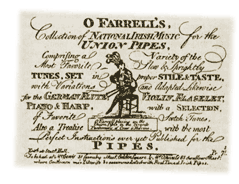 |
 | |||
|
The BodhránThe bodhrán is a shallow, one-sided drum of a type found in many cultures throughout the world. Is use in modern traditional music is mainly due to its adoption by the late Séan Ó Riada, who preferred it, in his arrangements for Ceoltóirí Cualann (latterly the Chieftains), to the snare-drums used in ceílí bands. Previously, it was associated with the annual forays of the Mummers or Wren-Boys, who used it to make a lot of noise - the Irish word bodhrán means 'deaf thing' or 'deafener'. The noise was sometimes accentuated by the addition of tambourine-style jingles to the rim, and the bodhrán is sometimes called a tambourine in some parts of the country. Indeed, it has been suggested that bodhrán is a corruption of 'bourine.
The skin most commonly used for the head of the bodhrán is goat; calf and even greyhound skin is also used, and it was reliably reported that a ring of greyhound procurers existed in Dublin " Riada's elevation of the bodhrán to the status of a musical instrument found approval in many quarters; however, it is only fair to say that many musicians regard it with derision, or, at best, with suspicion. The late Seamus Ennis, when asked how to play a bodhrán, replied, 'With a penknife.' There are reasons for this attitude. The bodhrán seems easy to play; to the non-musician who wants to be thought of as a musician the bodhrán seems an easily-acquired passport into a select company. Or it may be that he perceives the music as an entertainment which everyone may, or should, join in. Whatever the motivation, the results are sometimes execrable: a piano accordion, for example, accompanied by a battery of four or five aspiring bodhrán players, all producing personal variations on what they think is the beat is hardly likely to be music. On the other hand, the bodhrán can give good 'lift' to a session or to solo playing. The combination of flute and drum is a well-tried one, and many flute-players actively like a good bodhrán accompaniment. The bodhrán is played with a stick or with the hand. The stick can vary considerably in shape and dimensions: some players prefer to use one end of the stick and others like a leather loop on the stick, some like a big stick and others a wee stick. Playing with the hand involves a rocking motion between the thumb or ball of the thumb and the fingers or outside edge of the palm. Since the drum is open-ended, various shifts of timbre and pitch can be achieved by manipulating the hand, fingers or arm on the inside of the skin, and some virtuoso players, notably Johnny McDonagh of De Danann, have developed this technique to a very high level: the melodic line of a tune can be followed or counterpointed. Some players also vary the sound by playing a few bars on the wooden rim of the bodhrán, or on the studs which hold the skin in place. The effect, at times, is not unlike a machine-gun, and if you are not prepared for it, it can be very bad for the nerves. In group playing, the bodhrán - inspired, perhaps, by the example of jazz drummers - sometimes takes a solo. This can be good crack but it is not to be generally recommended except among consenting adults. >>> Next Page : How to play the Bodhrán |
[ Back to top ]
All Material © 1999-2018 Irelandseye.com and contributors


 some years ago. There are also several semi-apocryphal stories of lads ruining potential bodhráns by hunting them with shotguns or, on at least one occasion, a machine-gun. Some commentators find poetic justice in these anecdotes.
some years ago. There are also several semi-apocryphal stories of lads ruining potential bodhráns by hunting them with shotguns or, on at least one occasion, a machine-gun. Some commentators find poetic justice in these anecdotes.